
Discover the top 10 historical sites of Libya, from ancient ruins to iconic landmarks, perfect for tourists and history enthusiasts.
Here are ten historical sites that offer a unique perspective on Libya’s past:
1. Leptis Magna:
2. Sabratha:
3. Cyrene:
4. Apollonia:
5. Ghadames:
6. Tadrart Acacus:
7. Ubari Lakes:
8. Jebel Akhdar:
9. Benghazi Old Town:
10. Murzuq:
1. Leptis Magna in Libya:
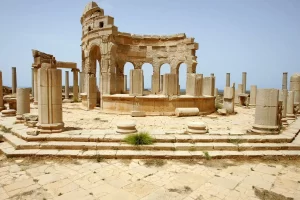
Leptos Magna, located on the coast of Libya near the modern city of Al-Khams, is one of the world’s most impressive and well-preserved Roman archaeological and historical sites for tourists.
Once a thriving city and an important part of the Roman Empire, Leptis Magna offers visitors a remarkable journey back in time to ancient Roman civilization.
The centerpiece of Leptis Magna is its vast and remarkably intact ruins, which include a majestic amphitheater, a sprawling forum, triumphal arches, temples, baths, and residential areas.
The grandeur of these structures reflects the city’s prosperity and significance during its heyday.
The Amphitheater of Leptis Magna is one of the largest in the Roman world, capable of seating up to 16,000 spectators.
Visitors can imagine the roar of the crowd as they watch gladiatorial contests and other public spectacles unfold in this impressive arena.
The Severan Basilica, a grand structure in the Roman Empire, not only displays intricate marble carvings, impressive columns, and soaring arches but also showcases Roman architectural excellence.
Nearby, the Arch of Septimius Severus, dedicated to the Roman emperor who was born in Leptis Magna, stands as a testament to the city’s importance in the empire.
One of the most striking features of Leptis Magna is its exquisite mosaics, which adorn the floors of villas and public buildings throughout the site.
These intricate artworks depict scenes from daily life, mythology, and the natural world, offering insights into Roman culture and aesthetics.
Despite being buried under sand for centuries, Leptis Magna has been remarkably well-preserved, allowing visitors to marvel at its grandeur and imagine what life was like in ancient times.
A visit to Leptis Magna is a journey through history, offering a captivating glimpse into the splendor of the Roman Empire in North Africa.
2. Sabratha in Libya:
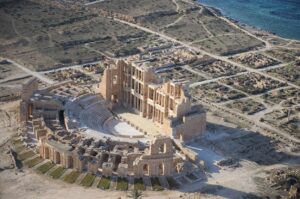
Sabratha, located along the Mediterranean coast of Libya, is an ancient city that flourished as a prosperous trading port during the Roman Empire.
Today, it stands as one of the most impressive archaeological and historical sites in Libya, attracting tourists from around the world with its well-preserved ruins and stunning seaside setting.
The highlight of Sabratha is its magnificent theater, which is among the best-preserved Roman theaters in the world.
Built in the 2nd century AD, the theater boasts a capacity of over 5,000 spectators and is still used for performances and events today.
Visitors can admire its grand architecture, including elaborately decorated columns and arched entrances, and imagine the vibrant spectacles that once took place within its walls.
Adjacent to the theater is the sprawling Sabratha Forum, a large public square surrounded by impressive colonnades, temples, and civic buildings.
The Forum served as the political, social, and economic hub of the city, where residents gathered for commerce, government proceedings, and religious ceremonies; consequently, it was a central point of daily life in the community.
Other notable features of Sabratha include the Temple of Isis, dedicated to the Egyptian goddess of magic and fertility, and the Basilica of Justinian, a Byzantine-era church adorned with intricate mosaics and marble carvings.
Sabratha’s seaside location adds to its allure, as sandy beaches and crystal-clear waters provide a picturesque backdrop to the ancient ruins.
Visitors can stroll along the waterfront promenade, take in panoramic views of the Mediterranean Sea, and, moreover, relax in the tranquil coastal surroundings.
With its impressive architectural heritage, scenic coastal setting, and rich history, Sabratha offers a captivating glimpse into the ancient world and is a must-visit destination for history enthusiasts and cultural travelers exploring Libya.
3. Cyrene in Libya:
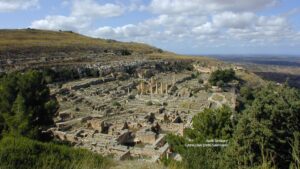
Cyrene, located in eastern Libya near the modern town of Shahhat, is an ancient Greek city that was once a prominent center of culture, philosophy, and learning in the Mediterranean world.
Founded in the 7th century BC, Cyrene flourished as one of the most important cities in the region, leaving behind a wealth of archaeological treasures that continue to captivate visitors today.
The ruins of Cyrene are spread across a picturesque hillside overlooking the Libyan countryside, offering stunning views and a serene atmosphere.
Visitors can explore the city’s well-preserved remains, including temples, theaters, agoras, and residential areas, which provide insight into daily life in ancient Greece.
The Temple of Apollo, one of the most iconic structures in Cyrene, therefore stands as a testament to the city’s religious significance.
This impressive Doric temple, dating back to the 7th century BC, features a row of towering columns and intricate carvings depicting scenes from Greek mythology.
Nearby, the Sanctuary of Demeter and Persephone, dedicated to the Greek goddesses of agriculture and the underworld, showcases the city’s religious devotion and architectural prowess.
The sanctuary’s well-preserved remains include a temple, altars, and sacred precincts where rituals and ceremonies were performed.
The ancient theater of Cyrene, with its sweeping views of the surrounding landscape, offers visitors a glimpse into the city’s cultural life and entertainment traditions.
The theater’s tiered seating and stage area provide a sense of the grandeur and spectacle that once characterized performances in ancient Greece.
With its rich history, magnificent architecture, and historical sites with natural beauty, Cyrene in Libya is a must-see for history buffs, archeology buffs, and cultural tourists to explore the treasures of Libya’s ancient past.
4. Apollonia in Libya:
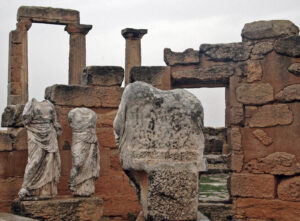
Apollonia, situated along the picturesque coastline of western Libya near the modern town of Susah, is an ancient Greek colony and Roman city that offers visitors a captivating journey back in time.
Founded in the 7th century BC by Greek colonists from Cyrene, Apollonia flourished as a center of trade, culture, and learning, leaving behind a wealth of archaeological treasures that continue to fascinate tourists today.
The ruins of Apollonia are spread across a scenic coastal landscape; moreover, the azure waters of the Mediterranean Sea serve as a stunning backdrop.
Visitors can explore the city’s well-preserved remains, including temples, theaters, public baths, and residential areas, which provide insight into daily life in ancient Greece and Rome.
The most iconic structure in Apollonia is the well-preserved theater, which dates back to the 2nd century AD and offers breathtaking views of the sea and surrounding countryside.
Visitors can envision the grandeur of ancient performances and entertainment while admiring the theater’s tiered seating and stage area.
Nearby, the Temple of Cybele, dedicated to the Phrygian goddess of fertility, showcases the city’s religious devotion and architectural prowess.
The temple’s Corinthian columns and intricately carved friezes are a testament to the skill and craftsmanship of ancient artisans.
The Archaeological Museum of Apollonia, located on-site, houses a fascinating collection of artifacts recovered from the excavations, including pottery, sculptures, and mosaics, providing further insight into the city’s history and culture.
With its stunning coastal setting, rich history, and impressive archaeological remains, Apollonia is a must-visit destination for history enthusiasts, archaeology buffs, and cultural travelers exploring the ancient wonders of Libya.
5. Ghadames in Libya:
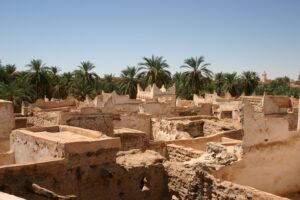
Ghadames, often referred to as the “Pearl of the Desert,” is an ancient oasis town located in the heart of the Libyan Sahara, near the borders of Algeria and Tunisia.
With its labyrinthine streets, traditional mud-brick architecture, and rich cultural heritage, Ghadames offers visitors a unique and unforgettable glimpse into centuries-old Berber culture.
The old town of Ghadames, known as the Medina, is a UNESCO World Heritage Site; furthermore, it is one of the best-preserved examples of a traditional desert settlement in North Africa.
Its narrow alleys and intricately designed buildings, adorned with geometric patterns and colorful motifs, showcase the ingenuity and craftsmanship of the local inhabitants.
Ghadames is known for its troglodyte houses, traditional underground dwellings carved into sandstone cliffs to offer shelter from heat.
Tadrart Acacus, located in the remote southwestern corner of Libya, is a stunning mountain range and desert landscape; furthermore, it offers visitors a unique and otherworldly experience.
Visitors can explore these unique homes; moreover, they can experience their cool, dimly lit interiors and intricately carved ceilings, gaining insight into the traditional way of life in the desert.
Ghadames is renowned for its ancient water management system, utilizing underground tunnels called qanats to supply water to gardens.
These qanats are a testament to the resourcefulness of the Berber people and their ability to thrive in the harsh desert environment.
In addition to its architectural wonders, Ghadames is known for its vibrant cultural scene, with traditional music, dance, and festivals celebrating the region’s rich heritage.
Visitors can also sample delicious local cuisine, including couscous, tagine, and dates, at the town’s markets and restaurants.
With its timeless charm, fascinating history, and warm hospitality, Ghadames offers travelers a truly authentic desert experience that is sure to leave a lasting impression.
6. Tadrart Acacus in Libya:

Tadrart Acacus, located in the remote southwestern corner of Libya, is a stunning mountain range and desert landscape; furthermore, it offers visitors a unique and otherworldly experience.
Designated as a UNESCO World Heritage Site, Tadrart Acacus is renowned for its striking natural beauty, prehistoric rock art, and rich cultural significance.
The landscape of Tadrart Acacus is characterized by towering sandstone cliffs, deep gorges, and expansive dune fields, creating a surreal and mesmerizing environment.
Visitors can explore the region’s dramatic rock formations, including towering spires and natural arches, while marveling at the ever-changing colors of the desert sky.
One of the most remarkable aspects of Tadrart Acacus is its wealth of prehistoric rock art, which dates back thousands of years and offers valuable insights into the lives and beliefs of ancient inhabitants.
The area is home to thousands of rock art sites; additionally, these sites contain paintings and engravings depicting scenes of daily life, hunting, rituals, and mythical creatures.
These ancient artworks are a testament to the region’s rich cultural heritage and the enduring creativity of its early inhabitants.
In addition to its natural and cultural attractions, Tadrart Acacus offers opportunities for outdoor adventures, including hiking, camel trekking, and camping under the stars.
Visitors can explore the region’s hidden valleys, discover hidden oases, and encounter the diverse wildlife that inhabits this remote corner of the Sahara Desert.
While Tadrart Acacus may be off the beaten path, its unparalleled beauty and cultural significance make it a must-visit destination for adventurous travelers seeking a truly immersive desert experience in Libya.
7. Ubari Lakes in Libya:
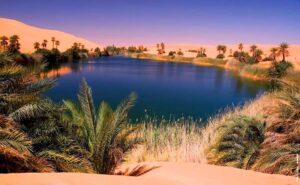
The Ubari Lakes, nestled in the heart of the Sahara Desert in southwestern Libya, are a series of stunning saltwater lakes that offer visitors a unique and mesmerizing landscape unlike any other.
Surrounded by towering sand dunes and rocky outcrops, these pristine lakes provide a tranquil oasis in the midst of the arid desert.
The Ubari Lakes are formed by a combination of natural springs and ancient fossil water, creating a haven for wildlife and vegetation in an otherwise inhospitable environment.
Visitors to the lakes can marvel at the shimmering turquoise waters, which contrast starkly with the golden sands of the surrounding desert.
Each of the Ubari Lakes has its own unique character and charm.
Some tall sand dunes set the scene, while beautiful palm groves and reed beds dot others.
The largest and most famous of the lakes is Lake Ubari, which is popular for its stunning beauty and vibrant colors.
In addition to their natural splendor, the Ubari Lakes are steeped in history and culture.
Tourists can explore ancient rock art and archaeological and historical sites can be found throughout this area of Libya, which has been inhabited by indigenous Berber tribes for thousands of years.
Visitors can explore these sites and, in addition, learn about the rich cultural heritage of the desert-dwelling peoples who have called the Ubari Lakes home for centuries.
For adventurous travelers, the Ubari Lakes offer a range of outdoor activities, including swimming, boating, and hiking.
Camping under the starry desert sky is also a popular option, allowing visitors to fully immerse themselves in the tranquility and beauty of this extraordinary desert oasis.
8. Jebel Akhdar in Libya:
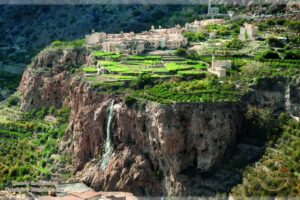
Jebel Akhdar, known as the “Green Mountain,” is a stunning region located in northeastern Libya, renowned for its lush landscapes, picturesque villages, and rich cultural heritage.
Rising to an elevation of over 2,000 meters, Jebel Akhdar offers visitors a refreshing escape from the arid deserts that dominate much of Libya’s landscape; thus, it provides a unique and contrasting experience.
The fertile slopes of Jebel Akhdar are carpeted with terraced fields, orchards, and olive groves, creating a patchwork of greenery that stands in stark contrast to the surrounding desert.
Visitors can explore the region’s charming villages, many of which are built from local stone and cling to the mountainside, consequently, they offer breathtaking views of the valleys below.
One of the highlights of Jebel Akhdar is, indeed, the traditional farming practices that have been passed down through generations.
Visitors can witness farmers tending to their crops using age-old techniques, including the cultivation of terraced gardens and the harvesting of olives and other fruits.
The region of Jebel Akhdar in Libya is also home to a number of historical sites and cultural attractions for tourists.
The ancient city of Cyrene, a UNESCO World Heritage Site, is located nearby; therefore, it offers visitors the chance to explore its well-preserved ruins and, furthermore, learn about its rich history as a Greek colony.
Jebel Akhdar provides hiking trails through rugged terrain with stunning views, ideal for spotting local wildlife like birds of prey.
Additionally, the region is home to a number of natural springs and waterfalls, providing opportunities for swimming and relaxation amidst the mountain scenery.
With its breathtaking vistas, vibrant culture, and outdoor adventures, Jebel Akhdar is a must-visit destination for tourists looking to experience the beauty and diversity of Libya’s natural landscapes.
9. Benghazi Old Town in Libya:
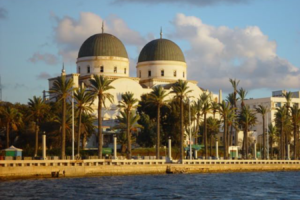
Benghazi Old Town, situated along the Mediterranean coast in northeastern Libya, is a historic quarter that offers visitors a captivating journey through time.
Steeped in history and culture, this ancient district is a testament to the city’s rich heritage and, furthermore, serves as a window into Libya’s past.
The heart of Benghazi Old Town is its bustling souq, or market, where visitors can wander through narrow alleys lined with shops selling traditional crafts, spices, textiles, and local delicacies.
The souq is a vibrant hub of activity, with vendors hawking their wares and locals going about their daily lives, providing a glimpse into the city’s bustling atmosphere.
Named after the Libyan resistance leader who fought against Italian colonization, this street is, therefore, a popular gathering spot for locals and tourists alike.
The old town features historic mosques and churches like Omar Al-Mukhtar Mosque and the Cathedral of the Immaculate Conception.
Visitors can explore Benghazi’s Old Town on foot, wandering through its labyrinthine streets and discovering hidden gems around every corner.
The district’s crumbling Ottoman-era buildings, with their intricate facades and ornate balconies, not only offer a glimpse into the city’s colonial past but also showcase its architectural splendor.
The Museum in the heart of the old town provides a deeper insight into the city’s history and culture with exhibits showcasing artifacts from Libya’s ancient civilizations and colonial period.
Benghazi Old Town in Libya offers a vibrant atmosphere, historical sites, and rich cultural heritage for tourists to explore.
10. Murzuq in Libya:
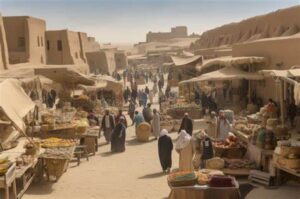
Murzuq, an ancient oasis town, surrounds the vast expanse of the Sahara Desert in southern Libya.
Steeped in history and culture, Murzuq offers visitors a glimpse into traditional Libyan life and the timeless beauty of the desert landscape.
The town’s most striking feature is its traditional mud-brick architecture, which has remained largely unchanged for centuries.
Visitors can wander through the narrow streets of the old town, admiring the intricately decorated facades of the buildings and soaking in the atmosphere of this ancient desert settlement.
Murzuq is also famous for its bustling markets, where locals gather to buy and sell goods ranging from spices and textiles to livestock and handicrafts.
The markets not only offer a vibrant glimpse into daily life in Murzuq but also provide an opportunity for visitors to interact with the friendly locals.
One of the highlights of a visit to Murzuq is, in addition, the opportunity to explore the surrounding desert landscape.
Guided tours are available for travelers looking to venture into the Sahara, where they can experience the awe-inspiring beauty of towering sand dunes, rocky outcrops, and ancient caravan routes.
Tourists interested in history and archaeology, Murzuq in Libya is home to several ancient rock art and historical sites that provide insight into the region’s rich cultural heritage.
The nearby Wadi Mathendous is particularly famous for its prehistoric rock art, which includes depictions of animals, hunting scenes, and human figures dating back thousands of years.
Despite its remote location, Murzuq offers a unique and unforgettable experience for adventurous travelers seeking to explore the untamed beauty of the Libyan desert and immerse themselves in the timeless culture of this ancient oasis town.







